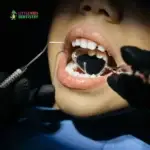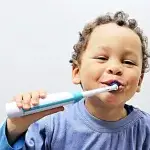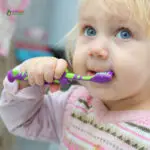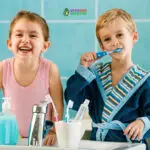If you’re a parent, you already know the tiny battles that come with daily brushing. From toddlers who chew on the toothbrush to older kids who “forget” to floss, oral care can feel like just another item on the to-do list.
But here’s the good news: in 2025, taking care of your child’s teeth is easier, more engaging, and more fun than ever before. And the benefits go far beyond sparkling smiles — healthy teeth help kids eat, speak, sleep, and grow with confidence.
In this post, we’ll cover everything parents need to know this year to stay ahead of cavities, calm dental fears, and create happy habits that stick.
1. Baby Teeth, Big Importance
It’s easy to think of baby teeth as temporary and not a big deal. But the truth is, they do more than just make your child’s smile adorable.
They help your child:
- Chew and speak properly
- Mantener el espacio para los dientes adultos
- Build healthy jaw development
Untreated cavities in baby teeth can lead to pain, infections, and even issues with permanent teeth later on. The earlier you start good oral habits, the better.
🍼 Consejo profesional: Begin brushing with a soft, damp cloth as soon as the first tooth appears. And yes — book that first dental visit by age 1!
2. Brushing Doesn’t Have to Be a Battle
If tooth time is a struggle in your house, you’re not alone. But in 2025, there are so many ways to make brushing a moment kids look forward to — or at least, not dread.
🪥 Try these tips:
- Use a fun toothbrush with their favorite character
- Play a 2-minute song or video while brushing
- Use apps that turn brushing into a game
- Let them brush your teeth while you brush theirs
For little ones, brushing is all about routine and fun. For older kids, it’s about independence and rewards. Find what motivates your child and make it part of their daily rhythm.
3. Healthy Teeth Start in the Kitchen
What your child eats has a huge impact on their dental health. In 2025, many pediatric dentists are focusing on nutrition-first prevention.
🍓 Best smile-friendly snacks:
- Crunchy fruits like apples
- Veggies like carrots and cucumbers
- Cheese and plain yogurt
- Nuts and seeds (age-appropriate)
🍭 What to avoid:
- Sticky candies (gummies, caramel)
- Sugary drinks (juice, soda, flavored milk)
- Constant snacking throughout the day
Water is your child’s best friend — it washes away food, keeps the mouth hydrated, and helps prevent cavities.
4. The Modern Dental Visit
Dental visits have come a long way. No more scary drills and white walls. Today’s pediatric dental offices feel more like playrooms or mini movie theaters than clinics.
In 2025, you can expect:
- TVs on the ceiling and headphones for distractions
- Gentle, patient dentists who use kid-friendly language
- Laser tools instead of drills (less noise, less pain!)
- Themed rooms and rewards after checkups
🌟 Look for a dentist who:
- Specializes in pediatrics
- Ofrece opciones de sedación si es necesario.
- Communicates clearly with both parents and kids
- Makes your child feel seen, safe, and comfortable
5. Preventive Care Is the Real Superpower
We all want to avoid fillings and dental emergencies. Luckily, 2025 is all about proactive care.
🦷 What’s worth asking your dentist about:
- Dental Sealants – thin coatings for molars that prevent cavities
- Fluoride Treatments – strengthen enamel and protect against early decay
- Digital Scans – quick and painless scans that spot issues early
- Orthodontic Screenings – even for young kids (as early as age 7)
A little prevention now saves a lot of stress (and money) later.
6. Calming Dental Fears (for Kids y Parents)
It’s completely normal for kids to feel nervous at the dentist — especially if it’s their first time. The key is familiarity and fun.
👧🏽 Try this at home:
- Role-play a “dentist visit” with stuffed animals
- Watch fun videos or cartoons about teeth (no scary ones!)
- Read books about dental visits before the appointment
- Avoid saying “it won’t hurt” — focus on “the dentist helps keep you healthy!”
Modern pediatric dentists are trained to handle anxiety with warmth, patience, and play. Let your child know it’s okay to feel unsure — but also remind them how brave they are!
7. Big Teeth, Big Changes
Around age 6, those adorable baby teeth start falling out and permanent teeth come in — and with that, a whole new phase begins.
🧒🏼 What to watch for:
- Crowding or crooked teeth
- Overbites, underbites, or early jaw issues
- Early loss of baby teeth (may require space maintainers)
- Habits like thumb sucking or teeth grinding
An early visit to an orthodontist (even before braces!) can help spot problems before they require major treatment.
8. Make Oral Health a Family Thing
Kids copy what they see — and that includes how you take care of your teeth. Turn brushing and dental care into a family ritual instead of a chore.
🏠 Fun ideas:
- Family brushing challenge (track mornings and nights!)
- Use a big wall calendar with star stickers
- Celebrate no-cavity checkups with a fun (non-sugary!) treat
- Let them “teach” their younger sibling how to brush
When oral care is normal, consistent, and positive, kids are more likely to keep those habits for life.
Final Thoughts: Smiles That Last a Lifetime
At the end of the day, what matters most is giving your child the tools — and confidence — to care for their own health.
In 2025, you don’t need to be a dental expert to raise a child with healthy teeth. You just need:
- A supportive dental home
- A little creativity with daily routines
- Consistent, caring encouragement
So whether your child is brushing for the first time, getting their first filling, or proudly showing off a lost tooth — remember: you’re building not just a healthy smile, but a foundation for lifelong self-care.
Let’s keep those little teeth big on health — one brush at a time. 🪥🦷💙










